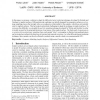Free Online Productivity Tools
i2Speak
i2Symbol
i2OCR
iTex2Img
iWeb2Print
iWeb2Shot
i2Type
iPdf2Split
iPdf2Merge
i2Bopomofo
i2Arabic
i2Style
i2Image
i2PDF
iLatex2Rtf
Sci2ools
109
click to vote
RT
2001
Springer
2001
Springer
Differential Point Rendering
In this paper, we propose a solution to adapt the differential point rendering technique developed by Kalaiah and Varshney to implicit surfaces. Differential point rendering was initially designed for parametric surfaces as a twostage sampling process that strongly relies on an adjacency relationship for the samples, which does not naturally exist for implicit surfaces. This fact made it particularly challenging to adapt the technique to implicit surfaces. To overcome this difficulty, we extended the particle sampling technique developed by Witkin and Heckbert in order to locally account for the principal directions of curvatures of the implicit surface. The final result of our process is a curvature driven anisotropic sampling where each sample ”rules” a rectangular or elliptical surrounding domain and is oriented according to the directions of maximal and minimal curvatures. As in the differential point rendering technique, these samples can then be efficiently rendered using...
Computer Graphics | Implicit Surface | Point Rendering Technique | RT 2001 | Twostage Sampling Process |
Related Content
| Added | 30 Jul 2010 |
| Updated | 30 Jul 2010 |
| Type | Conference |
| Year | 2001 |
| Where | RT |
| Authors | Aravind Kalaiah, Amitabh Varshney |
Comments (0)

